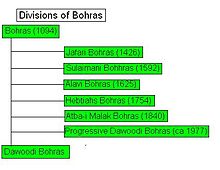Dawudi Bohras

The Dawudi Bohras or Dawudites ( Da'udiyya ) are Ismaili Muslims. They are followers of a sub-branch of the Tayyibi - Ismailis . The Tayyibites are one of the two branches of the Musta'li Ismailites, with the other branch being that of the Hafizites .
The largest Musta'lite group is that of the Bohras , of which the Dawudi Bohras , mainly found in India , is the largest.
The highest religious dignitary is the Dā'ī al-Mu ṭ laq (الداعي المطلق), until the beginning of 2014 this was the 52nd Dā'ī al-Muṭlaq Syedna Mohammed Burhanuddin . His successor is the 53rd Dā'ī al-Muṭlaq Mufaddal Saifuddin (born 1946).
Disagreement about the identity of the 19th imam divided the Ismailis: the Bohras believed that al-Mustali (d. 1101) would be the 19th imam, while the Nizari Ismailis believed that this was his older brother, Nizār (d. 1095) ). In 1132 the 21st Imam of the Musta'li-Tayyibi - Ismaili lineage , Abū l-Qāsim at-Taiyib , went into secrecy . This series of imams continues to this day in secret. Since al-Tayyibi's obscurity , the community has been led by a number of dā'ī heads (religious propagandists, missionaries); these leaders have the title of dā'ī al-Muṭlaq .
history
The history of the Bohras is characterized by numerous divisions, mainly due to differences over the succession of the various Dā'ī al-Mutlaq:
After the death of the 26th Dā'ī al-Muṭlaq, Da'ud ibn 'Ajab , in 1591, the succession was controversial. The community was divided into: the Dawudites, who followed Qutb Shah ibn Da'ud , while the Sulaymanis were on the side of Sulayman ibn Hasan . The Dā'ī al-Muṭlaq of the Dawudites resided in India from then on .
After the death of the 28th Da'i (1634) the Alavi Bohras (not to be confused with the Alevis ) took Ali bin Ibrahim to the Da'i. They live mainly in Pakistan and India .
In 1754, when the 39th Da'i, Syedna Ibrahim Wajihuddin died , the branch of the Hebtiahs Bohras was formed .
In 1840 the 46th Dā'ī al-Muṭlaq of the Dawudi Bohras, Syedna Muhammad Badruddin , was appointed Da'i at the age of twenty-six and died four years later: This incident sparked a new round of dissent and the Atba was formed -i Malak Jama'at .
In the 1970s, there was renewed political division, with a group breaking away from that led by the 52nd Da'i, the progressives Dawudi Bohras , led by Asghar Ali Engineer (1939-2013).
literature
- Farhad Daftary : Brief History of the Ismailis. Traditions of a Muslim Community (= culture, law and politics in Muslim societies . Volume 4 ). Ergon, Würzburg 2003, ISBN 3-89913-292-0 (English: A Short History of the Ismailis . Translated by Kurt Maier).
- Farhad Daftary: Historical Dictionary of the Ismailis . 2012, books.google.de
- Max Kasparek, Sonja Hock: Yemen: The Haraz Mountains: Nature - Culture - Trekking. Hiking in a beautiful terrace landscape between fortified villages in mountain Yemen . German Society for Technical Cooperation (GTZ) and Yemen General Tourism Authority, 2006, books.google.de
- Eva Paul: The Dawoodi Bohras - an Indian community in East Africa . (PDF) FU Berlin
Footnotes and individual references
- ↑ Or Ṭayyibī ( Arabic طيبي) etc.
- ↑ Melvyn Thomas: Dr Sayedna Burhanuddin no more, pal of gloom descends on Dawoodi Bohras in Surat . In: The Times of India . 17th January 2014.
| Dawudi Bohras (alternative names of the lemma) |
|---|
| Dā'ūdīs; Da'udis; Daudis; Dawoodis; Dawoodi Bohra Shias; Dawudiyya |


